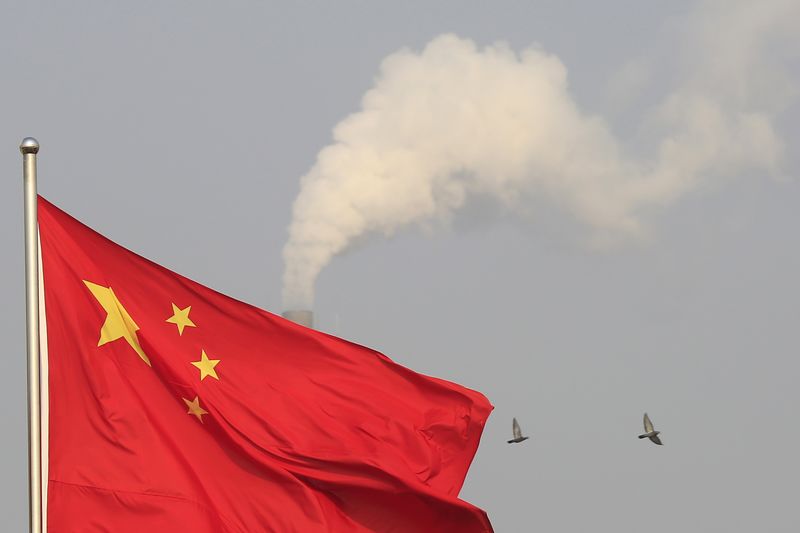(Bloomberg) -- A $300 million plan to turn a country town famous for fine porcelain into a major tourist destination gives clues as to how China’s new approach to stimulus works in reality.
Shenhou in central Henan province, home to the delicately-colored jun pottery since the Song dynasty about 1,000 years ago, began work in 2016 restoring its main street. The investment is starting to pay off: During February’s week-long Lunar New Year holiday, Shenhou saw a quarter of a million visitors, boosting tourism revenue 90 percent from a year earlier.
About 500 million yuan ($74 million) alone was spent restoring Shenhou’s previously dilapidated Ancient Street, or Lao Jie, and its surroundings. Now, a walled archway greets visitors to the newly paved thoroughfare, where red lanterns and ornate roofs overlook shops stocked with fine earthenware.
“Before, only those interested in porcelain culture came here, but now even many young people come to check out the place,” said Li Jing, owner of a nearby ceramics shop. “This has driven business across the board: at hotels, restaurants, businesses, every way you can imagine.”
Since last year, the government has doubled down on this kind of “targeted” stimulus, emphasizing the role of consumption and the promotion of a long-standing shift toward services and higher-value manufacturing -- and away from expensive mega-projects.
It’s a big jump for a country more used to the command-economy style of Communist tradition, according to James Laurenceson, deputy director of the Australia-China Relations Institute at the University of Technology in Sydney.
“Governments in China have less experience with delivering in this way,” he said. “It’s not immediately clear how many jobs it can create, and I expect there will still be significant waste as some default to old approaches.”
Despite policy makers’ determination to avoid a repeat of previous investment binges, the new stimulus strategy shares a lack of transparency over financing arrangements that plagued old-style investment spending. Local government offices contacted multiple times by telephone declined to provide details of the town’s financing arrangements.
The 2 billion yuan investment that’s planned for Shenhou is almost 30 times the town’s 2016 fiscal revenue. That’s largely because it’s among 1,000 “special towns” prioritized for development by 2020 to encourage traditional culture, the natural environment or modern manufacturing.
Overall though, the relative restraint of the new stimulus strategy should help slow a build up of debt that’s headed toward 300 percent of gross domestic product. That holds out the hope that economic growth becomes more sustainable in the longer term. The flip-side is that the boost to growth is weaker, lacking the credit-driven sugar highs that helped China support the global expansion after the 2008 financial crisis.
The muted impact of China’s more calibrated approach to stimulus is expected to be confirmed in economic data scheduled for release Wednesday. Growth is seen ticking down a notch to 6.3 percent in the first quarter from a year earlier, according to the median estimate of economists in a Bloomberg survey.
More importantly, the full-year expansion is seen slowing to 6.2 percent from 6.6 percent last year -- the weakest pace since 1990. The moderate stimulus approach represents Beijing’s acquiescence in the long-term deceleration of the world’s second-largest economy.
Industrial production, fixed-asset investment and retail sales are all seen picking up a tad, underscoring what some economists see as early signs of the economy’s stabilization after slowing continuously since early 2018.
China’s policy stimulus is now both more decentralized and consumption orientated than in the past, reflecting a broader, permanent reconfiguration of the economy, said Citigroup Inc (NYSE:C). analysts led by Mark Schofield in a note.
Policy makers have implemented sweeping tax cuts to help shore up consumption, are striving to funnel more credit to efficient private companies rather than lumbering state enterprises, and cut red tape.
President Xi Jinping has also given himself more wiggle room by lowering the annual growth target to a range of 6 to 6.5 percent this year, down from about 6.5 percent last year.
In Henan, the provincial government plans to spend 1.9 trillion yuan this year to boost “effective investment.” About 20 percent of that spending is directed toward “modern services” that include tourism developments such as Shenhou, shopping malls and logistics centers.
Half a dozen businesses interviewed last week in Shenhou, a town of about 50,000 two hours drive from Henan capital Zhengzhou, were upbeat about the recent surge in tourist arrivals. Some even complained about chronic traffic jams and a shortage of parking at weekends and public holidays.
Stage two, scheduled to get underway next month, will see another 800-meter stretch of Ancient Street restored over more than two years. Overall investment upgrading Shenhou will reach 5 billion yuan over an unspecified period, says the local government.
Future plans include the construction of a traditional porcelain heritage park and a culture and art center, said Shanghai-based Joyu Group, the company contracted to run the town’s tourist area, in an emailed response to questions.
Longer-term prospects for China’s new stimulus approach are hard to judge just yet. For Shenhou, much will depend on whether the second stage of the development can create a more varied experience for visitors, said the owner of cafe Heshuiba on Ancient Street, who asked to be referred to by only her family name, Miao.
“People who come here once won’t come back,” said Miao. “There aren’t enough specific attractions here. Our success depends on the second stage. I hope they can build it up well.”
To contact Bloomberg News staff for this story: Xiaoqing Pi in Beijing at xpi1@bloomberg.net;Kevin Hamlin in Beijing at khamlin@bloomberg.net
To contact the editors responsible for this story: Jeffrey Black at jblack25@bloomberg.net;Malcolm Scott at mscott23@bloomberg.net
©2019 Bloomberg L.P.
